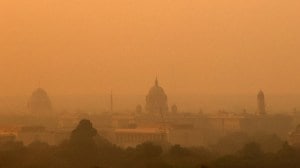Drought forces villagers into sanctuary
The drought in Rajasthan has forced an ugly turn in the traditional battle between authorities at the Ranthambhor National Park in Sawai Mad...

The drought in Rajasthan has forced an ugly turn in the traditional battle between authorities at the Ranthambhor National Park in Sawai Madhopur and residents of villages ringing the sanctuary. On August 21, around 50 villagers entered Ranthambhor alongwith hundreds of cattle, openly violating a Supreme Court directive which bars grazing within the park. Determined to enforce a law that has been defied every monsoon, the Sawai Madhopur SP, M N Dinesh, cracked the whip, arresting 15 offenders.
Field Director and Conservator, G V Reddy, told The Indian Express, ‘‘There is hardly any grass within the park this year and our three primary sources of water—the Padam Talab, Raj Bagh and Malik Talab—have reached rock bottom. If we allow villagers inside, what will happen to our wildlife?’’ Section 144 now governs the park. Laying siege to the unprotected hills around the park, around 200 policemen from the RAC and the Special Task Force have set up 11 naka bandis around the sanctuary and have been conducting flag marches and raids in many of the 96 villages encircling it.
But the drought has pushed the villagers in the direction of defiance. Former sarpanch of Khilchipur village, a kilometre away from the park, says, ‘‘We are going through the fourth year of drought. We have no fodder for our starving animals. What are we supposed to do?’’ According to Reddy, the Collector has agreed to set up 16 fodder depots outside the sanctuary, but there’s no sign of them so far.
In the underdeveloped Khandar tehsil, from where some villagers were arrested, passions run high. ‘‘Where do those of us who have no land go? Animals from the park wander into our fields and destroy them. Why can’t we cut grass from inside?’’ Reddy however asserts that ‘‘the villagers have sufficient grazing land outside the park which has been encroached upon by rich farmers for agriculture. Politicians, including an ex BJP MLA, are cashing in on the situation. Why do they only want to graze their cattle on the 298 sq kms within the park?’’
Grazing rights during the three monsoon months has been a long-standing bone of contention between villagers and the park authorities. In 1982, the then Field Director, Fateh Singh Rathore, was beaten up by villagers who trespassed into the park with their cattle. In 1987-88, the then Collector B B Mohanty, was said to have been suspended for permitting grazing within the park. And in 1995, an enraged mob burnt down a forest chowki. According to Reddy, forest employees have even faced death threats from villagers.
The fact remains that no permanent solution has been found for a genuine fodder problem that crops up every year. A Rs 28 crore World Bank Eco Development Project launched in 1996 hasn’t got off the ground. To date, only Rs 12 crore has been utilised—in fact the project took off only in 1998 and recieved a two-year extension after its five-year term expired in December 2001. According to a Project Performance Review published in June 2002, the utilisation for eco-development of surrounding villages was all of 35.25%.
The social impact of the project, launched in seven of the country’s major sanctuaries, has been dismissed as miniscule in Ranthambhor due to faulty planning and slothful release of funds by the state government. The bulk of money was spent on construction of buildings for forest officials. Apart from giving 13,582 gas connections to villagers, not much has been achieved.
Eco-development committees have been set up in only 33 of the 96 villages around the park. Reddy offers the excuse that,‘‘ villagers are not supportive of the project and World Bank procedures are very cumbersome.’’



- 01
- 02
- 03
- 04
- 05




























